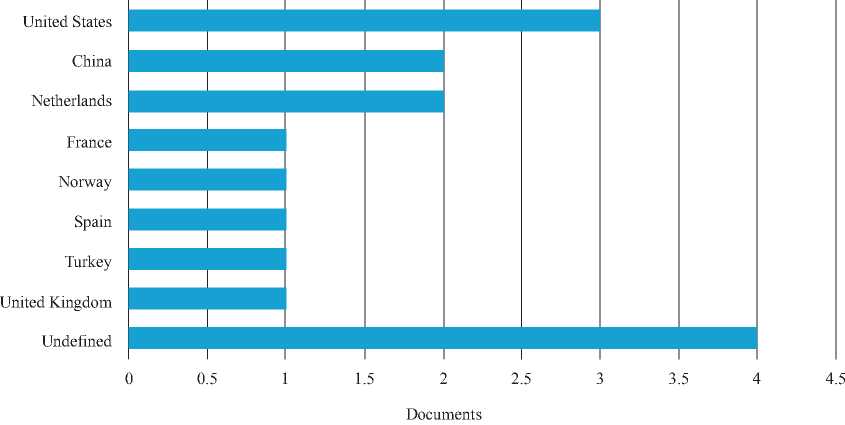
Ship Science & Technology - Vol. 17 - n.° 34 - (35-43) January 2024 - Cartagena (Colombia)
DOI: https://doi.org/10.25043/19098642.248
Erika Tatiana Ruíz Orjuela 1
Wilson Adarme Jaimes 2
1 Universidad Nacional de Colombia. Bogotá, Colombia. Email: erruizo@unal.edu.co
2 Universidad Nacional de Colombia. Bogotá, Colombia. Email: wadarmej@unal.edu.co
Date Received: November 21st, 2022 - Fecha de recepción: 21 de noviembre de 2022
Date Accepted: February 25th, 2023 - Fecha de aceptación: 25 de febrero de 2023
Sustainability is a topic of interest on the agenda of governments, companies and academics worldwide. Changing practices in supply chain management to decrease environmental and social impact has become more important. The shipping industry is also facing these challenges and is looking to incorporate new technologies and processes for supply chain management. However, depending on the context, previous studies have identified different factors that influence the successful implementation of sustainable practices. The objective of this study is to review the barriers and facilitators that influence the implementation of sustainable supply chain management policies in the shipping industry through a literature review and evaluate their relationships.
Key words: Sustainability, Marine, Logistics, Supply chain.
La sostenibilidad es un tema de interés en la agenda de los gobiernos, las empresas y académicos a nivel mundial. Cambiar las prácticas en la gestión de la cadena de suministro para disminuir el impacto ambiental y social se ha vuelto más importante. La industria naval se enfrenta también a estos desafíos, por lo que busca la incorporación de nuevas tecnologías y procesos para la gestión de su cadena de suministro. Sin embargo dependiendo del contexto estudios previos han identificado diferentes factores que influyen en el éxito de la implementación de prácticas sostenibles. El objetivo de este estudio es realizar una revisión sobre las barreras y facilitadores que influyen en la implementación de políticas de gestión sostenible de la cadena de suministro en la industria naval a través de una revisión de literatura y evaluar sus relaciones.
Palabras claves: Sostenibilidad, Naval, Logística, Cadena de suministro
As society becomes aware of global warming and environmental problems, companies are increasingly questioning the environmental sustainability of their production processes and supply chains [1], [2]. This applies to a wide variety of sectors. However, those related to marine transportation have received particular attention, as they generally develop their ship and equipment design, construction, and improvement processes close to at-risk and protected ecosystems such as marine and river ecosystems [3]-[5]. In addition, companies must keep up with environmental practices for competitive reasons.
The concept of sustainability in the supply chain is defined as the integration of environmental thinking into supply chain management, including product design, material sourcing and selection, manufacturing processes, delivery of the final product to consumers, as well as end-of-life management of the product [1], [6] - [8].
The shipping industry is concerned about the environment. Especially those related to environmental problems, such as resource depletion and pollution caused by transportation. Cruise ships and cargo ships account for almost 30% of global emissions of smog-forming sulfur oxide and almost 10% of SO2 emissions from burning fossil fuels [5], [9]-[11]. Entities such as the IMO (International Maritime Organization), have issued standards that seek to reduce the amount of greenhouse gas emissions generated by a ship. Based on the above, the shipping industry has characteristics that make it interesting and relevant to study sustainability practices in the supply chain. A challenge for organizations operating in naval supply chains is to balance gaining a competitive advantage and acting in a sustainable manner while maintaining reputation, legitimacy, and credibility, as well as meeting the expectations of various stakeholders. As a result, sustainability issues along the supply chain can affect the financial and operational performance of organizations [6]. Therefore, sustainable supply chain management has become an important research topic. This research topic combines the concepts of supply chain management and sustainability. Three dimensions of sustainable development, economic, environmental, and social performance are considered [9].
Studies on green or sustainable supply chain management focus on the internal operations of the pivot company or on the green management practices developed within it [8]. Previous studies identified that facilitators are context and sector specific, therefore the objective of this paper is to build a theoretical framework on barriers and facilitators that influence the implementation of sustainable Supply Chain practices in the shipbuilding industry [11], [12]. Based on the above, the specific contributions of this paper are derived from the following research questions: What barriers affect the implementation of sustainable supply chain practices in the shipbuilding industry and how organizations seek to overcome them? What facilitators affect the implementation of sustainable supply chain practices in the shipbuilding industry and what is their importance?
To meet the objectives of this article, two phases are carried out, the first is a literature review that aims to map and review the existing literature to identify research opportunities and define the frontiers of knowledge and in the second phase a MICMAC Analysis- Cross Impact and Multiplication Matrix applied for a classification into four categories: autonomous, dependent, linkage and independent [13].
Based on the PRISMA (Preferred Reporting Items for Systematic reviews and Meta-Analyses) protocol for scoping review [14], the following are the guiding aspects for the literature review.
After performing the search equation in the SCOPÚS database, a total of 16 articles were identified, then the VosViewer® software was used to perform a bibliometric analysis of the results obtained. To perform this analysis, the results were first cleaned in each of the databases, eliminating duplicate records and applying a cleaning list to group the authors; the thesauri were also applied. The results of the bibliometric analysis are presented below.
According to the following figure, the number of related articles has had an increasing trend over time, with the majority of publications in the last 5 years.
In terms of countries, according to Fig. 2, the United States, China, the Netherlands, France, Norway, Spain, Turkey and the United Kingdom are identified as the leaders in the number of articles produced on this topic. In general, the geographical dispersion of these organizations indicates that the research has been of interest to institutions and research centers worldwide and has had a recent interest in this field of research.

To identify emerging themes, a keyword analysis was performed using VOSviewer. Co-word analysis applies text mining techniques to article titles, abstracts, and keywords. The relationship between keywords is determined based on the number of articles in which the keywords appear together [15]. To perform the analysis, the results of the search equation were combined. Coding errors in sources, links and cited references were corrected for further analysis. From this analysis 3 clusters emerged interlinked by the words in the center of the map: "Shipbuilding", "supply chain management" "sustainability" indicating a high interrelation of the keywords with the other clusters: 1) sustainable supply chain practices, 2) shipbuilding industry mission processes and 3) measurements or effects on the environment (Fig. 3).
Fig. 3. Keyword co-citation network.

Fig. 1. Number of articles published per year.
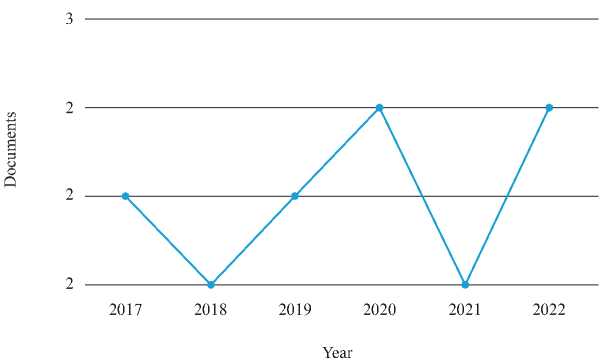
The culture of sustainability in all actors that are part of the chain is essential to align strategies. Collaboration among actors has been defined as the collaborative paradigm that is essential to achieve competitive advantage through sustainable supply chain management. However, the authors indicate that depending on the national context in which an organization operates these enablers may vary [16]. In addition, technological integration and information exchange are also considered fundamental; in this case, coordination mechanisms that contribute to and promote integration among actors with the sustainability of the supply chain as the central axis are discussed [3].
A requirement for the successful implementation of sustainability practices in the supply chain is related to the commitment of top management [3], however, as for the other employees of the organization, their participation and specific support for the implementation of practices is also required [3]. Research also highlights the allocation of resources for purchasing, training and other elements required for sustainable practices [1].
Likewise, the culture of sustainability in all the actors that are part of the chain is essential to align strategies. Collaboration among actors has been defined as the collaborative paradigm that is essential to achieve a competitive advantage through sustainable supply chain management. However, the authors indicate that depending on the national context in which an organization operates these enablers may vary [16]. In addition, technological integration and information exchange are also considered fundamental; in this case, coordination mechanisms that contribute to and promote integration among actors with the sustainability of the supply chain as the central axis are discussed [3].
Consistent with the previous section, the authors identify the lack of commitment and support from top management, the lack of commitment and understanding by all stakeholders and the fact of not having practices aligned with mission strategies as barriers to the successful implementation of sustainable practices. In addition, resource and financial constraints act as barriers. Furthermore, the lack of structures and processes, i.e. the level of organizational maturity of the companies also limit their successful implementation.
On the other hand, aspects at the national level, such as norms and regulations, restrict or limit the sustainable behavior of the chain, since only compliance with standards is guaranteed without generating innovation processes on sustainability. In addition, purchase decisions based on price or lack of demand for sustainable products are barriers that are related to customer behavior [11], [17]. Another significant aspect of potential barriers is related to the buyer-supplier relationship. Finally, lack of cooperation, unwillingness to share information, considering environmental and social standards as additional costs that do not add value, limit the implementation of sustainable practices [2], [4].
Based on the documents analyzed, the factors identified, which can act as barriers or facilitators depending on their absence and development at the organizational level, are presented in general (Table 1).
Table 1. Factors influencing the implementation of sustainable practices.
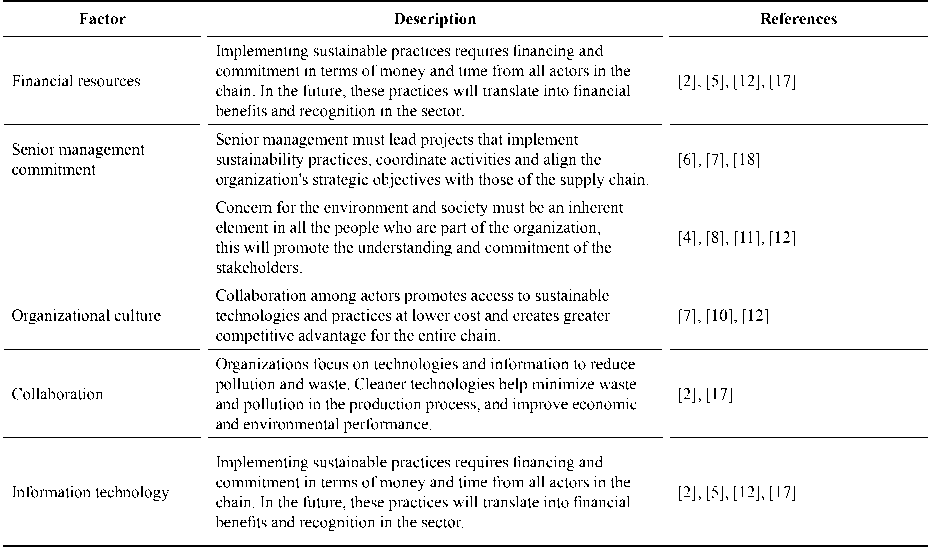
Considering that the objective of the work is to prospectively know the relationship between these factors in the shipbuilding industry, the academic exercise was based on the articles initially identified and based on that the researchers performed the MICMAC analysis, which is presented in Fig. 4.
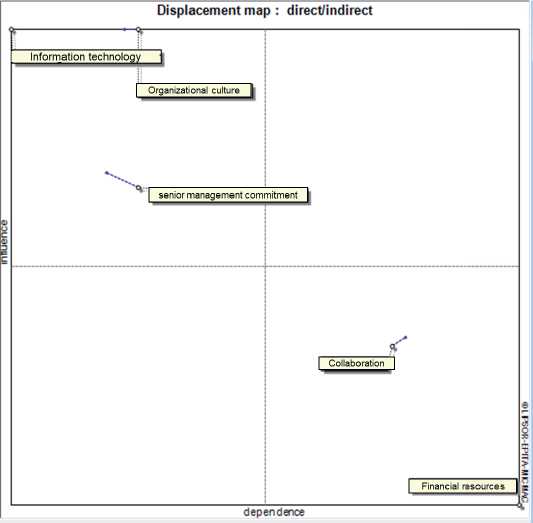
The determining factors are located in the upper left quadrant, part of the system depends on these and can become facilitators or barriers, in this quadrant are: Information technologies, organizational culture and top management commitment. The results factors are in the lower right quadrant, where collaboration and financial resources are located, these factors require monitoring to verify the effectiveness of the system.
Finally, Fig. 5 of direct influence shows that there are two strong relationships between these factors which correspond to: Information technology (ICT) and collaboration (C) and the relationship between top management commitment (SMC) and organizational culture (OC). The above allows validating the information found through the content analysis of the articles.
Fig. 5. Direct relationship of factors.
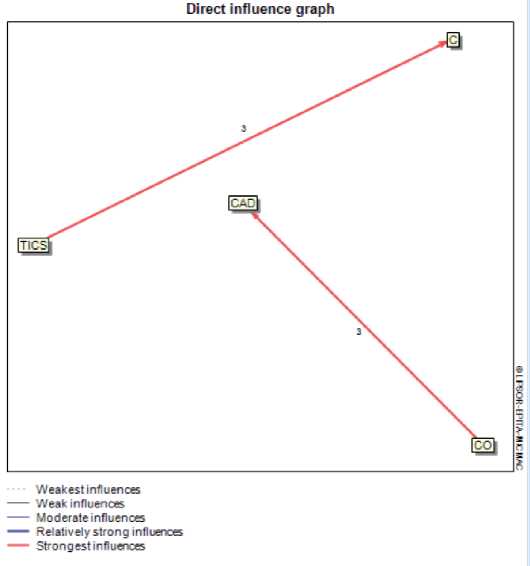
This paper adds to the emerging field of study that seeks to investigate the context for implementing successful sustainable supply chain practices in the marine sector. This paper presents a theoretical framework on barriers and enablers. In the first phase, a literature review was presented to identify these factors, then based on content analysis the relationships between them were evaluated. The identification of enablers helps supply chain practitioners and strategic decision makers to identify key elements that require attention to implement practices. Barriers are a major obstacle during the implementation phase and pose significant challenges and require special attention. Based on the MICMAC analysis, the determining factors are identified as Information Technology, organizational culture and top management commitment. The objective is to make them facilitators.
The recommendations based on the results obtained are: first, companies in the shipbuilding sector can increase their level of implementation practices through investment in information technology that encourage collaboration, information exchange between chain actors in a proactive and collaborative manner. Secondly, they could start training their employees in sustainable practices such as design for the environment, life cycle analysis, recycling, and other environmentally proactive practices to create environmental awareness within the company as well as in supplier companies and customers along the entire supply chain. Finally, the commitment of top management, which is measured not only through the financial resources granted for the implementation of sustainable practices but also through improved coordination and collaboration among actors, to achieve successful implementation of these practices throughout the supply chain.
Finally, it should be noted that there is a possibility of bias in the analysis, which could be the objective of future research using quantitative techniques. In addition, the MICMAC analysis does not identify the relative weights of the variables represented in the model, so a more in-depth analysis using a structured questionnaire survey is required.
[1] A. A. HERVANI, M. M. HELMS, AND J. SARKIS, "Performance measurement for green supply chain management," Benchmarking An Int. J., vol. 12, no. 4, pp. 330-353, Jan. 2005, doi: 10.1108/14635770510609015.
[2] Y. LI AND J. YANG, "How Government Subsidy Impacts on the Supply Chain Decision for LNG-Fuelled Ships," Math. Probl. Eng. vol. 2022, 2022, doi: 10.1155/2022/1680489.
[3] V. M. RAO TUMMALA, C. L. M. PHILLIPS, AND M. JOHNSON, "Assessing supply chain management success factors: a case study," Supply Chain Manag. An Int. J., vol. 11, no. 2, pp. 179-192, Jan. 2006, doi: 10.1108/13598540610652573.
[4] P. GILBERT, P. WILSON, C. WALSH, AND P. HODGSON, "The role of material efficiency to reduce CO2 emissions during ship manufacture: A life cycle approach," Mar. Policy, vol. 75, pp. 227-237, 2017, doi: 10.1016/j.marpol.2016.04.003.
[5] M. TANTAN AND H. CAMGOZ-AKDAG, "Sustainability concept in Turkish shipyards," WIT Trans. Ecol. Environ. vol. 241, pp. 269281, 2020, doi: 10.2495/SDP200221.
[6] J. W. STRANDHAGEN, S.-V. BUER, M. SEMINI, E. ALFNES, AND J. O. STRANDHAGEN, "Sustainability challenges and how Industry 4.0 technologies can address them: a case study of a shipbuilding supply chain," Prod. Plan. Control, vol. 33, no. 9-10, pp. 995-1010, 2022, doi: 10.1080/09537287.2020.1837940.
[7] P. DESAI, R. SAREMI, S. HOFFENSON, AND C. LIPPIZI, "Agile and affordable: A survey of supply chain management methods in long lifecycle products," 2019, doi: 10.1109/SYSCON.2019.8836861.
[8] M. C. J. CANIELS, E. CLEOPHAS, AND J. SEMEIJN, "Implementing green supply chain practices: an empirical investigation in the shipbuilding industry," Marit. Policy Manag. vol. 43, no. 8, pp. 1005-1020, 2016, doi: 10.1080/03088839.2016.1182654.
[9] G. CLANCY, M. FROLING, AND G. PETERS, "Ecolabels as drivers of clothing design," J. Clean. Prod. vol. 99, pp. 345353, 2015, doi: https://doi.org/10.1016/j.jclepro.2015.02.086.
[10] M. C. J. CANIELS, E. CLEOPHAS, AND J. SEMEIJN, "Implementing green supply chain practices: An empirical investigation in the shipbuilding industry," in 75th Annual Meeting of the Academy of Management, AOM 2015, 2015, pp. 323-328, doi: 10.5465/ AMBPP.2015.49.
[11] H. WANG AND Y. ZHAO, "Studies of the construction and evaluation of green shipbuilding supply chain system," Energy Educ. Sci. Technol. Part A Energy Sci. Res., vol. 32, no. 5, pp. 4361-4366, 2014.
[12] M. BIRON, Industrial Applications of Renewable Plastics: Environmental, Technological, and Economic Advances. Les Ulis, France: Elsevier Inc., 2016.
[13] P. K. BOCK, "Micmac," vol. v. 15. Smithsonian Institution, Washington, D.C., pp. 109-122, 1978.
[14] S. BEST AND S. J. WILLIAMS, "What Have We Learnt About the Sourcing of Personal Protective Equipment During Pandemics? Leadership and Management in Healthcare Supply Chain Management: A Scoping Review," Front. Public Heal. vol. 9, 2021, doi: 10.3389/fpubh.2021.765501.
[15] N. J. VAN ECK AND L. WALTMAN, "Software survey: VOSviewer, a computer program for bibliometric mapping," Scientometrics, vol. 84, no. 2, pp. 523-538, 2010, doi: 10.1007/s11192-009-0146-3.
[16] A. AWAYSHEH AND R. D. KLASSEN, "The impact of supply chain structure on the use of supplier socially responsible practices," Int. J. Oper. Prod. Manag. vol. 30, no. 12, pp. 1246-1268, Jan. 2010, doi: 10.1108/01443571011094253.
[17] M. RAMIREZ-PEÑA, A. J. SÁNCHEZ SOTANO, V. PÉREZ-FERNANDEZ, F. J. ABAD, AND M. BATISTA, "Achieving a sustainable shipbuilding supply chain under I4.0 perspective," J. Clean. Prod. vol. 244, 2020, doi: 10.1016/j.jclepro.2019.118789.
[18] V. WILSON, P. WENNBERG, K. DEGRAW, AND M. FLEISCHER, "An Improved 'Make versus Buy' Strategy for Future Material Acquisiton," J. Sh. Prod. vol. 17, no. 2, pp. 8791, 2001.